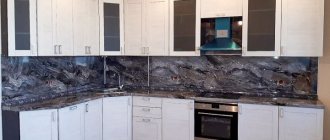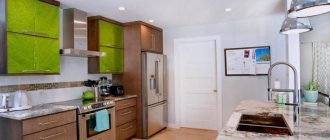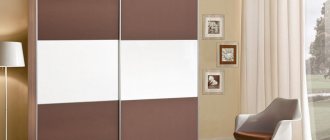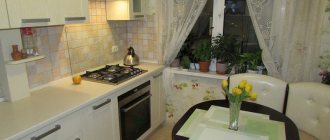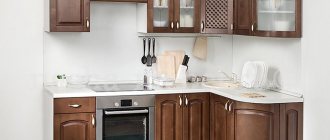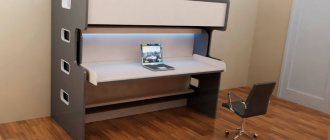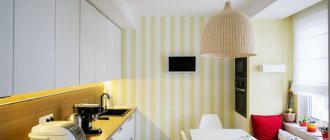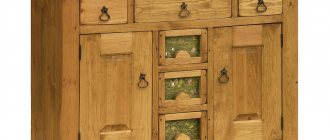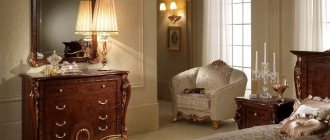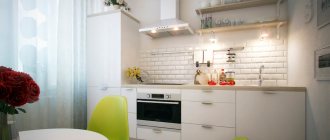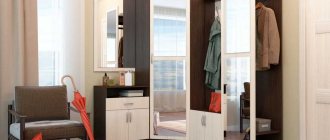Modern kitchen sets are made from a variety of materials. They are subject to general requirements: environmentally friendly, resistant to moisture and heat and, of course, beautiful.
Kitchens made from MDF are very diverse.
Kitchens made from MDF, a medium-viscosity wood-fiber board, fully comply with these parameters. Durable and affordable material is one of the most popular in the manufacture of kitchen sets.
What kind of material is this
Content
Some people believe that chipboard, fiberboard and MDF are similar materials. But they are very different in appearance and structure. Native color – light brown, with an admixture of gray. It has many shades - depending on the wood and bark used.
For the production of furniture and finishing materials, the surface of the boards is painted, laminated with film, covered with veneer or plastic.
Thanks to the fine-fiber structure, when milling and drilling, dust does not crumble, but dust is formed, which allows you to set completely different shapes and fully use the fasteners.
Decoding the abbreviation
MDF – MDF – medium-density fiberboard – medium-density fiberboard. That is, MDF is medium-density fiberboard. If you add chipboard, then the difference between the three types seems to be only in particle size. Chipboard - shavings, fiberboard - wood dust, MDF - something in between, small sawdust.
MDF is also deciphered as a finely dispersed fraction.
But in fact, MDF and fiberboard are considered completely different materials. And this difference is determined not only and not so much by the sizes of the particles, but by what connects them. We are talking about lignin, that plant component that distinguishes the trunk from the stem. Strength component.
It is thanks to him that MDF is the most durable and environmentally friendly of the three named materials. Provides complete absence of formaldehyde resins. But also the most expensive.
Production technology
Production is basically similar to making chipboard.
Wood waste is crushed almost to fibers, cleaned of foreign fractions, washed and dried. Under high temperature exposure, a tape of the required width is obtained. They are further pressed under high pressure, which releases lignin, which binds wood pulp. Further pressing removes air and forms an MDF structure. Which is ground to the desired surface evenness and thickness.
Often, the lignin released is not enough, so other binders are added: formaldehyde of emission class F1 (the safest of formaldehydes, allowed in furniture for children and hospitals), as well as urea resins.
Additives are used to increase moisture and fire resistance.
The structure of the material allows us to produce products of different sizes and thicknesses, but also of various shapes and reliefs. At the same time, the production technology allows the density of the slabs to vary significantly: from 760 to 1100 kg/m3.
Distinctive characteristics
MDF sheet differs significantly from chipboard:
- twice as strong;
- significantly more plastic, denser;
- easier to process;
- has a better appearance;
- practically environmentally friendly;
- chips do not form when fastened with screws, and in general they work much better with fasteners;
- more durable;
- significantly more expensive.
Thanks to its unique qualities, in some cases it can withstand competition with natural wood:
- more practical;
- It does not require special care;
- cheaper.
Content
- MDF: what is the material
- Video: which is better - MDF or chipboard
- Features of operation and care
- Types of painted facades
- How to care for facades with film
- Advantages and disadvantages of the material
- Cons of glossy plastic panels
- Video: material manufacturing technology
Types of panels
They vary in characteristics and sizes. There are three types:
- whole pressed;
- laminated;
- moisture resistant.
Fully pressed - without decorative coating.
They are painted during construction. The front part of the panel is sanded, primed and a layer of paint is applied with a spray gun. A hardener is added to weatherproof paint. And the results are visually attractive moisture-resistant panels.
It is better to use factory-painted panels. Then dry painting is also possible: the coloring powder is sprayed over the panel, the surface is subjected to high-temperature treatment, and the pigment in the powder melts. And a high-quality colored layer is formed.
Laminated - covered on one side with a moisture-resistant film. The film protects from moisture and temperature changes. The variety of decorative patterns on the film increases the already high demand as a finishing material in furniture.
Moisture resistant - made from the densest wood fractions that do not allow vapor and moisture to pass through. They are the most durable and moisture resistant. The most expensive group of panels.
Panels are also distinguished according to the type of finish on the front side. The most expensive option is finishing with veneer, a thin cut of natural wood, attached to the main board in different ways.
The most common type of MDF panels – laminated – also has a high decorative potential. Despite the fact that the main purpose of lamination is to improve the functional qualities of the panels: to increase wear and moisture resistance.
The enormous decorative potential is due to the possibility of laminating perforated boards.
When laminating, a thin film (melamine or paper-resin) is fused onto the panel.
A special type of MDF panels is milled. Due to special pressing, a relief side is created. Which is then painted or covered with film.
In rooms without high humidity and temperature, a special type of panels is used - paper-laminated panels. In closets, wardrobes and other rooms where it is desirable to use breathable material, similar MDF panels are actively used.
Panels are also distinguished by shape:
- rack type (multiple difference between length and width);
- tiled type (rectangular or square). If they are square, then usually with a side of a meter. But more often they are rectangular with an arbitrary aspect ratio;
- sheet panels. Most often used when cutting furniture.
Color palette
Any colors and shades, all types of wood and stone can be found in MDF panels presented in stores.
Wenge - a tree from Africa
A fashionable combination of colors is contrasting, nuanced:
Decorating with photo printing is also in fashion:
Properties of laminated chipboard
Laminated chipboards (LDSP) are characterized by low cost, resistance to temperature changes and a wide range.
The laminated coating can be made in almost any color and texture, which allows you to choose laminated chipboard furniture for the interior in any style. It belongs to the economy class because it has an affordable price.
Furniture made entirely of laminated chipboard has straight lines and looks more laconic even with a beautiful image on the film.
It should be noted that chipboard is used to make a durable material lined with plastic, which is called postforming. It goes into the production of countertops. However, this is not laminated chipboard in the usual sense.
Among the disadvantages of laminated particle boards are the tendency to chip on the surface and the impossibility of milling. The latter property makes it impossible to obtain smooth angles and bevels, or a relief surface.
LDSP differs from MDF for the worse in that it is less resistant to moisture. Although there are also moisture-resistant types of panels, their price is much higher.
If part of the laminate breaks off from the chipboard, the board may emit harmful fumes. This is also a disadvantage, since we should not forget that formaldehyde glue is used to adhere the chips in the slabs. Melamine film can protect against fumes of toxic formaldehyde. It is from this that lamination is made. Manufacturers make sure that the film adheres to the surface as firmly as possible, completely covering it. The safety of laminated chipboard largely depends on its quality.
Note! If the question arises about what is better to choose for the bedroom: laminated chipboard or MDF, then you should opt for the second one or prefer a combined option.
However, certified products that meet European standards (class E1, indicated in official documents) are quite safe to use in any residential area. It is best to choose (if possible) products made in Austria and Germany. At the same time, it is important to properly care for it, avoiding damage.
Dimensions
MDF panels.
Three length options: 244, 262, 280 cm.
Five width options: 10, 12.5, 15, 17.5, 25 cm
Thicknesses – from 10 to 18 mm. In the case of veneer covering - up to 60 mm.
MDF boards.
Dimensions depend on surface texture:
- 2.8x2.07 m – embossed, perforated and imitating stone;
- from 29 to 95 cm – side of square panels for decorative panels;
- from 1.5x0.1 to 1.5x0.9 m – dimensions of other slabs;
- from 3 to 30 mm – plate thickness.
For guidance in the weight of the panels: 2.8x2.05x0.003 m = 16 kgWhere MDF is used
Where is MDF used?
In short, the scope of application of MDF is the human environment. The entire perimeter of the room can consist of them - in the form of floor and ceiling coverings. The walls are covered with its panels, including soundproofing ones.
Window sills, table tops, furniture fronts, trim, baseboards, moldings - they find application everywhere.
Facades
Furniture façade – the front part of the furniture. The choice of material determines the class of kitchen furniture, which means the kitchen and room.
MDF Plastic
The types of MDF facades are mainly determined by the coating:
- laminated with polyvinyl chloride film (PVC);
- covered with high-gloss film;
- high gloss enamel;
- veneered coating;
- with bent elements.
You can add more painted ones.
Laminated High Gloss Film
.
High gloss enamel Natural veneer Curved
Advantages:
- without smell;
- cheaper than wood;
- tolerates changes in temperature and high humidity much better than wood;
- does not crack or collapse longer;
- bent shapes are easy to manufacture.
Do MDF facades have disadvantages? - Yes. Peeling at the corners over time. In addition, some do not tolerate moisture well.
Apron
The kitchen apron is the part of the wall between the surface of the unit and the cabinets above. Its main purpose is to protect the wall from grease and moisture. This determines the requirements for it.
We can say that an MDF apron optimally solves these problems. Some types of slabs are better, others are worse, for example, some react poorly to moisture. The qualities of MDF have already been described several times above.
Tabletop
For the last decade, it has been considered that the most designer element of the kitchen is the countertop. Despite the fact that this is a trend, it is also subject to the financial capabilities of young families. And for them, the ideal option is an MDF tabletop. Especially with a plastic coating.
It is suitable for many styles (including those available to young families): Minimalism, High-tech, Art Deco, Modern... It can fulfill any desire of the young owners.
Doors
There is a split in society - many believe that the best interior doors are natural wood, but there are also many who believe that MDF is no worse, but cheaper.
Wooden doors are definitely less resistant to temperature changes and high humidity. Their shape changes and separation begins.
What about MDF doors?
Available on the market:
- Smooth panel boards (frame, core and cladding). On top of the frame there are MDF sheets, the filler is corrugated cardboard or hardboard, which reduces the weight of the door, but reduces the strength.
- Panel milled - the same thing, but with milled MDF. Milling involves denser slabs.
- Drawstrings - same as 1), but filled with hollow MDF, which makes them heavier, improves their performance properties and increases their cost.
- Paneled - the frame is pine, and the panels are MDF.
- Molded - consist of 2-3 parts (MDF), fastened with durable glass.
MDF doors (all of the above), unlike wooden ones, do not change shape over time and in conditions of high humidity. But much cheaper.
Ceiling
One of the main advantages of MDF panels in ceiling decoration is excellent sound insulation. And thermal insulation. Plus the opportunity to solve the design of the room in a non-trivial way using cheap means. PVC panels have received a serious competitor, skillfully hiding flaws in the ceiling and preventing flooding from above. Looking great.
The MDF ceiling is easy to install, even with your own hands. The slabs are easy to clean - just a damp cloth is enough.
The disadvantages are the same as all MDF - a tendency to catch fire and a poor relationship with moisture. An exception is laminated and glossy waterproof panels.
Windowsill
The main task of the window sill is to prevent heat from leaving the room and cold air from entering from the street. Plus an important element of interior design. In addition, it must be strong enough to bend and protrude no more than 5-6 cm from the wall. Constant exposure to sunlight imposes a requirement for ultraviolet resistance.
WPC – wood-polymer composite. Judging by the table, MDF window sills are inferior to it in only one indicator. And they are noticeably superior to chipboard window sills.
Wall panels
Wall MDF is sufficiently described above. In addition, the following can be noted:
- MDF wall panels combine perfectly with various inserts;
- Due to these panels, you can expand the space of the room by arranging the panels vertically and alternating dark with light;
- veneered or laminated MDF will make the kitchen modern and stylish. They may completely displace ceramic tiles from the kitchen;
It is better to sheathe partitions with veneer panels or with photo printing.
conclusions
High-quality and beautiful kitchen furniture will always be a hot topic. Modern residential interiors dictate their own rules. A huge variety of furniture fittings help solve the most difficult problems in selecting individual sets for the kitchen space.
The main thing is that the kitchen furniture is not only pleasing to the eye, but also that it is modern and functional. Kitchens made from MDF materials are not only popular and in demand, but also fully meet international quality standards.
What kind of finishing is there?
The finishing depends on the design of the front surface of the panels and their density.
Veneering
A thin slice of wood (usually elite varieties) is attached to the slab:
- vacuum connection;
- glue;
- thermal pressing.
Externally, such slabs are practically indistinguishable from wooden panels.
But they are lighter and cheaper.
Caring for veneer is the same as caring for wood - protect from moisture and scratching with sharp objects.
Veneer panels made in the form of panels or mosaics acquire artistic value.
Plastic
The plastic coating is twice as durable as the film coating. And just as many times more durable.
Not afraid of the sun, moisture, mechanical damage. The weak point is the edges. And cannot be restored if damaged.
More expensive than painted and film ones.
PVC film
Covering with PVC film is not afraid of ultraviolet radiation, moisture, and protects from dirt. But there is also a minus - peeling at high temperatures.
High gloss film
It is obtained by hot vacuum pressing of PVC film on membrane-vacuum presses.
Resistant to abrasion and cleaning agents. Chic appearance. Wide variety of colors.
But does not tolerate sunlight and high temperatures.
Coloring
The need to paint MDF occurs in two cases - if it is necessary to restore the old coating or if you want to make a solid pressed board (CP) decorative.
The restoration procedure is simple: sand, clean, prime, dry, apply layers of paint with hardener (in proportions 1:9). Applying 3 layers will require at least a day, since the drying time for each layer is 8 hours. It is highly advisable to varnish (or polish) at the end.
Painted MDF from CPU does not require sanding (it has already been done by the manufacturer), it is enough to clean the joints, and then prime and paint, as in the previous case.
Painted facades
Painted facades can be ordered in a wide range of colors. They can be:
- matte;
- chameleon;
- pure color;
- steel metallic.
The advantage of such facades at a fairly high price category is their long service life.
A high-quality facade cannot contain foreign inclusions or roughness. Visual inspection shows a perfectly mirror surface.
This is achieved by grinding at different levels:
- primer;
- dye;
- varnish
This façade is made using special technology and requires precise execution of all stages. The resulting result will please the owners for a long period of time. It is for this type of MDF that it does not matter whether it is painted on one or both sides. Such panels are not afraid of water, steam, or moisture.
Experts who make furniture do not recommend choosing facades based on chipboard or plastic with its application on one side. Caring for a painted facade requires cleaning approximately every six months. Ease of maintenance depends on the ergonomics of furniture designs. Surface care is simple.
A regular window cleaner will work for this. If any grease stains remain, you can wipe them with a sponge or cloth with detergent.
The surfaces are fairly easy to clean and are not susceptible to heavy contamination.
How to choose MDF
Selection options:
- type and purpose of the premises;
- indoor structures;
- temperature and humidity conditions
Type of room
Loggia, kitchen, unheated rooms - moisture-resistant panels.
Living room, office - preference for slabs with veneer. Choose the color depending on the chosen style.
Children's room - bright glossy slabs, slats, panels of a suitable theme.
Indoor structures
The walls and floor are in the same style.
Interior partitions without doors - with tiles.
Combined living room and kitchen - perforated stove instead of partitions.
The apron in the kitchen is moisture-resistant panels insulated from heat.
Installation methods
You can do the installation yourself.
The difference is in the installation of panels for walls and ceilings: in the use of a metal profile and suspension for the ceiling and sheathing for walls.
A sufficient gap is left between the ceiling and walls for electrical wiring, which is outlined by a line around the perimeter of the room.
The ceiling is drawn into meter squares. The profile is attached along the lines, and hangers are attached at the points of intersection of the lines.
If the walls are not very smooth, then installation is on a frame. In this case, the cross-section of the bars must be sufficient to neutralize all the unevenness of the wall. Usually 20x30 mm. The distance between the bars is approximately 40 cm.
Installation diagram of sheathing and wall panels:
Installation of corners and joints:
Installation option No. 2 – adhesive – for walls that are almost flat.
The walls are leveled, primed, and the slabs are glued. The latter is done by applying glue (liquid nails or SM-11) in a zigzag pattern to the back of the slab and pressing the slab against the wall. The plate is immediately removed so that after 5 minutes it is finally glued. The joints are puttied.
In the case of large sheets, it is better to mount them on a frame.
Concrete coatings are pre-treated with an antiseptic.
In places for chandeliers and sockets, holes are pre-cut in the plates (67 mm in diameter).
For installation on the floor, denser moisture-resistant boards (from 900 kg/m3) are used.
If installation is on a subfloor, then you can use thinner sheets - 5 mm. If for logs, then at least 10 mm.
Don't forget about fittings for slab joints.
